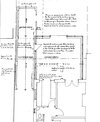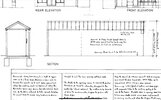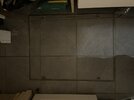Hi, we have an absolutely freezing attached utility room which we would like to insulate to make it more pleasant and economical to heat in the winter months.
It is approx 9m x 1.9m internally. Outside is rendered. It has an internal manhole with a sealed/tiled cover (near the front doors), sink and washing machine, front upvc doors, an internal access door into the house kitchen (which was a conservatory, now is a 2022 extension), and french doors to the rear garden. The roof has a fair bit of loft roll insulation (no access but could see this when the roof was opened up to re-tile last year). There is a double radiator connected to the house combi. It’s all plasterboarded up and fitted with kitchen units (see pic).
Plans from 2002 state the walls were built with single 100mm block work, except the wall adjoining the kitchen which has a cavity with 85mm rockwool (I have seen this confirmed when the extension was built).
The tiled floor is (was) continuous with the now replaced old kitchen conservatory (same tiles so presume same underneath): nominally a 100mm screed on concrete, but this was variable in the extension 100 to 30mm due to the slab level being a bit iffy.
My questions:
1. Insulating internal walls is presumably relatively simple ? Remove plasterboard, 100mm PIR between the block work piers? Given the width of the room I don’t want to lose any space , so minimal or zero second layer of PIR over the top to inculcate the piers?
2. Is there a cost/benefit discussion to be had about whether removing the tiles and screed and installing a floating PIR floor is worth it? From the experience in the conservatory we would only be able to fit between 20 to 75mm in order to maintain the floor level. There is also the question of disturbing the manhole cover.
Any advice would be very much appreciated.
It is approx 9m x 1.9m internally. Outside is rendered. It has an internal manhole with a sealed/tiled cover (near the front doors), sink and washing machine, front upvc doors, an internal access door into the house kitchen (which was a conservatory, now is a 2022 extension), and french doors to the rear garden. The roof has a fair bit of loft roll insulation (no access but could see this when the roof was opened up to re-tile last year). There is a double radiator connected to the house combi. It’s all plasterboarded up and fitted with kitchen units (see pic).
Plans from 2002 state the walls were built with single 100mm block work, except the wall adjoining the kitchen which has a cavity with 85mm rockwool (I have seen this confirmed when the extension was built).
The tiled floor is (was) continuous with the now replaced old kitchen conservatory (same tiles so presume same underneath): nominally a 100mm screed on concrete, but this was variable in the extension 100 to 30mm due to the slab level being a bit iffy.
My questions:
1. Insulating internal walls is presumably relatively simple ? Remove plasterboard, 100mm PIR between the block work piers? Given the width of the room I don’t want to lose any space , so minimal or zero second layer of PIR over the top to inculcate the piers?
2. Is there a cost/benefit discussion to be had about whether removing the tiles and screed and installing a floating PIR floor is worth it? From the experience in the conservatory we would only be able to fit between 20 to 75mm in order to maintain the floor level. There is also the question of disturbing the manhole cover.
Any advice would be very much appreciated.







